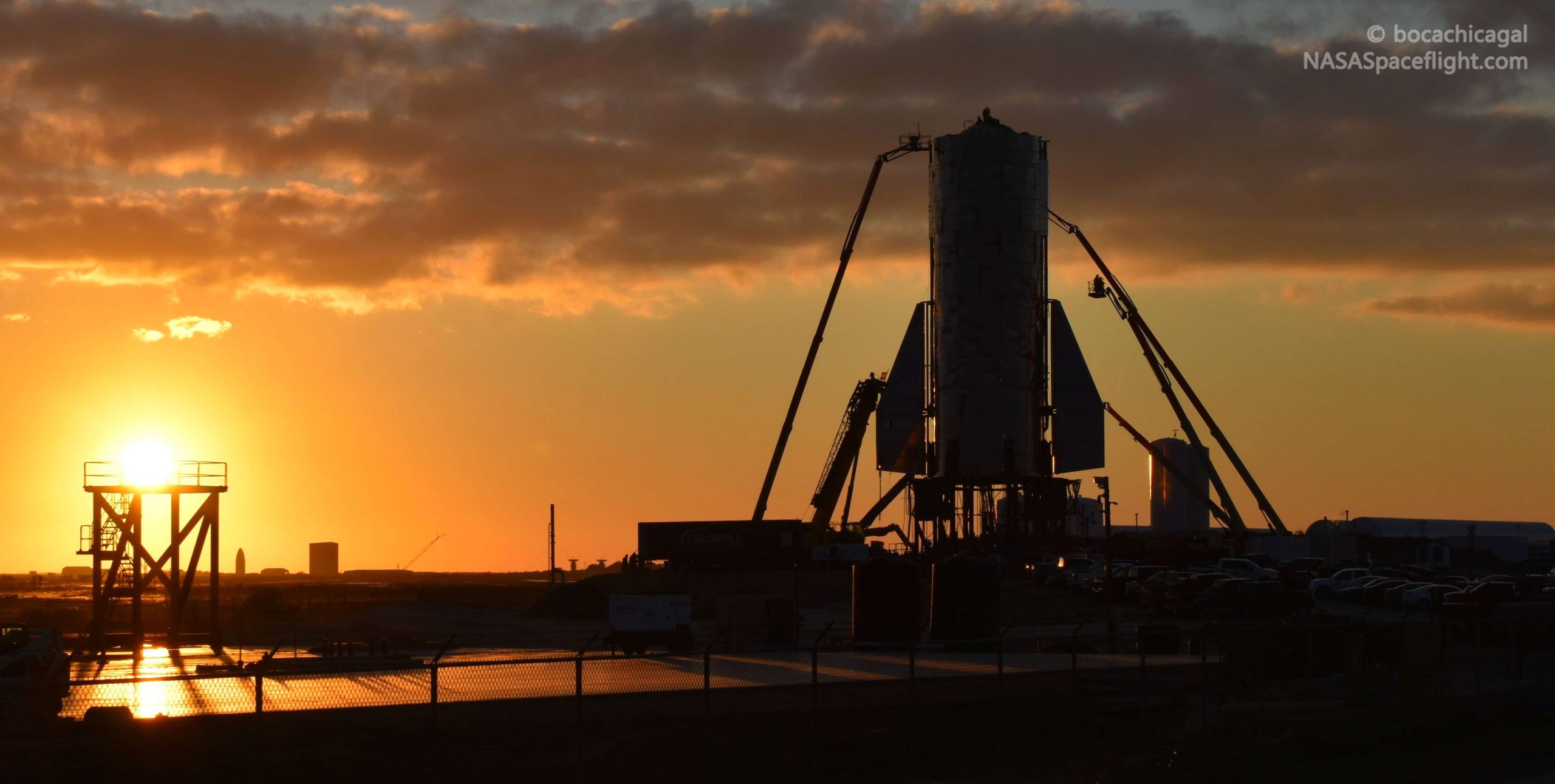
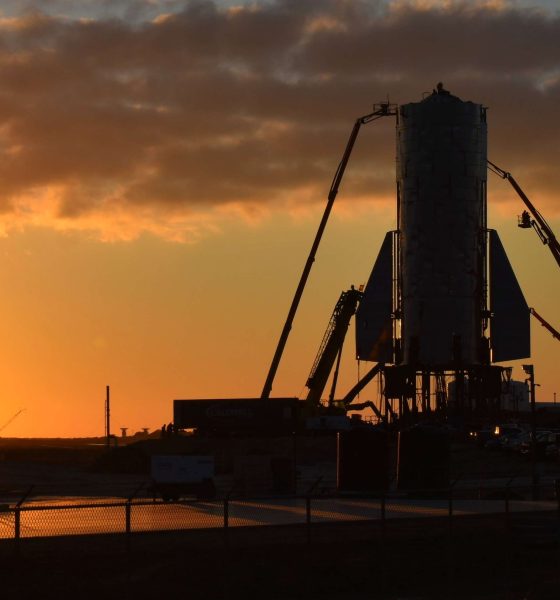
News
SpaceX Starship Mk1’s most important tests yet could begin just hours from now
SpaceX’s South Texas Starship Mk1 prototype is on the verge of kicking off a critical period of ground tests, ranging from tank pressurization and propellant loading to the rocket’s first triple-Raptor engine static fire. The campaign could begin soon – perhaps as soon as later today, in fact.
Over the last two weeks, SpaceX’s South Texas team has faced bad winter weather, among the many other challenges associated with building giant rockets almost entirely out in the elements. Nevertheless, company technicians and engineers continue to check off task after task along the path towards Starship Mk1 completion, the next-generation launch vehicle’s first full-scale, high-fidelity prototype.
In the month of November alone, SpaceX has (re)installed Starship Mk1’s nose and aft section flaps (this time outfitted with heavy-duty actuator mechanisms), nearly completed the process of routing and integrating the vehicle’s external liquid and gas plumbing, and more or less finished a barebones launch mount. Starship Mk1 was snugly attached atop that launch mount around the start of the month and workers have continuously swarmed around the rocket and pad in scissor and boom lifts and ever since, closing out umbilical connections, insulating cryogenic propellant pipes, and much, much more.
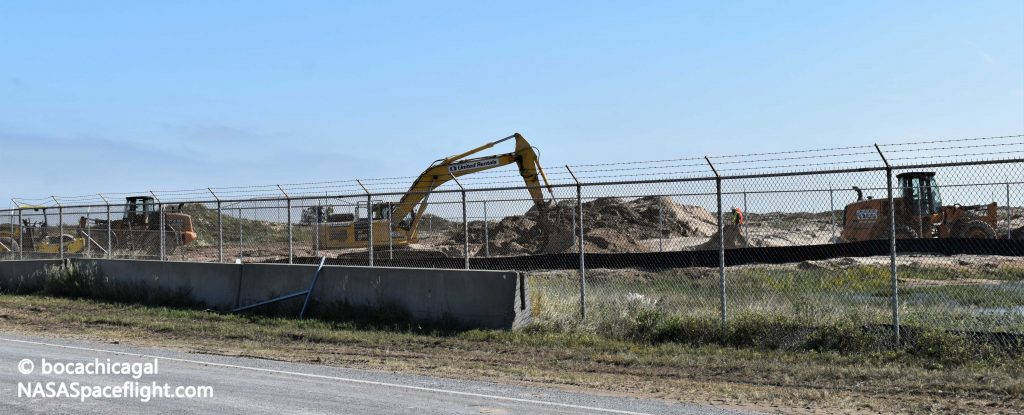
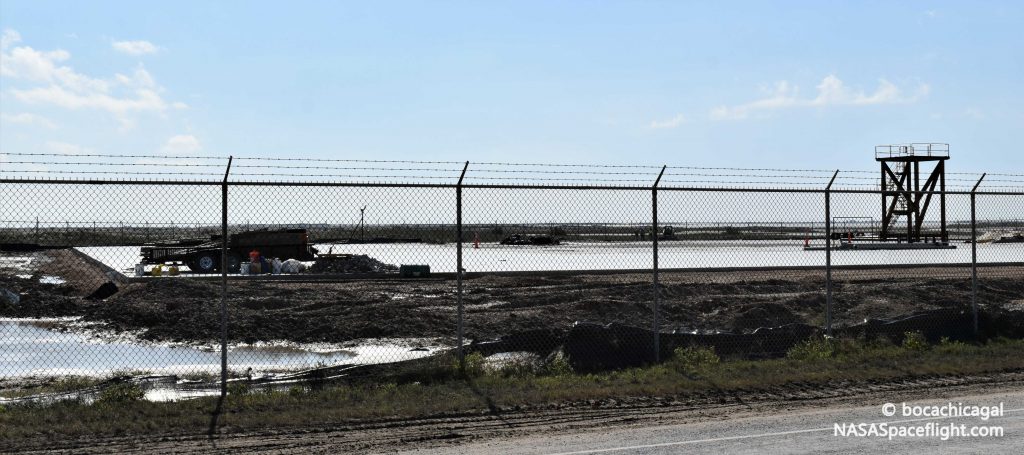
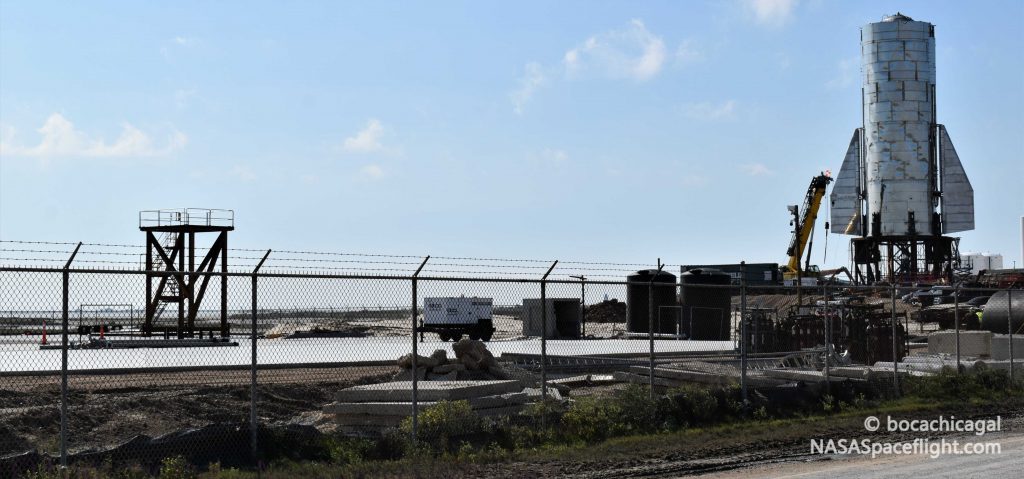
Within the last week or so, SpaceX has apparently also begun the process of expanding its presence around its existing Boca Chica pad facilities, where Starship Mk1 is preparing for testing. The purpose of that expansion is unclear, but the first phase – extending the existing square landing pad – is essentially complete and will presumably give Starship Mk1 a better chance of successfully landing in the event that its first skydiver-style landing attempt is not as accurate as predicted.
Based on official renders/mockups in SpaceX’s updated 2019 launch animation, it could also eventually become the foundation of a much more permanent integration and processing hangar, much like the hangars that SpaceX uses to integrate Falcon 9 and Heavy at its Florida and California launch sites. It could even be the foundation for a dramatically larger Super Heavy-class launch mount and water-cooled flame deflector like the one shown in that same video. For now, Starship Mk1 will begin testing (and presumably first flights) off of a minimal steel mount that was built up from almost nothing in barely two months.
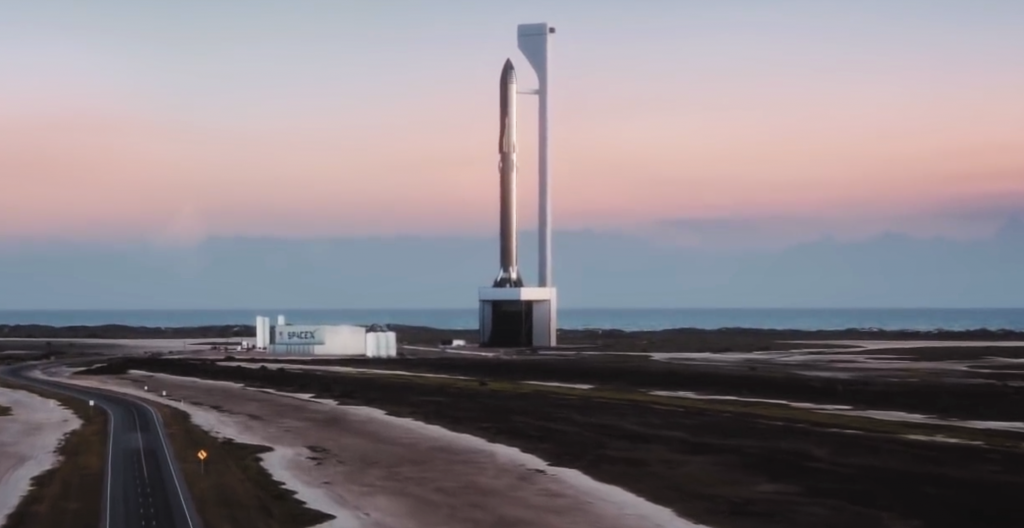
No nose, no problem?
As previously discussed on Teslarati, the testing Starship Mk1 is preparing for could take a number of routes to completion, but all of those routes will likely involve several main events. First, SpaceX may or may not decide to do a preliminary tank proof test with neutral (i.e. non-explosive) liquid nitrogen, which would verify the structural integrity and determine if there are leaks in what is essentially a building-sized pressure vessel.
SpaceX may instead skip that – it would require a vast and unwieldy quantity of liquid nitrogen – and move directly into the first cryogenic propellant loading test, in which SpaceX would attempt to fully fill Starship’s tanks with liquid oxygen and liquid methane. Assuming Starship Mk1 is 1:1 scale, that could involve as much as 1200 metric tons (2,650,000 lbs) of propellant, more than twice as much fuel as a Falcon 9.
In other words, Starship’s inaugural propellant loading attempt will be almost at the same scale as Falcon Heavy’s, which took several attempts, broke some hardware, and was a major learning experience and challenge on its own. A structural failure or explosion could be absolutely catastrophic, as those ~1200 tons of fuel and oxidizer could act as a massive bomb under the right conditions.
According to road closure notices published by Cameron County, SpaceX is expected to begin operations that require road closures as early as November 18th from noon to 8 pm CST, with backups on the 19th and 20th. Another window opens on the 25th at the same time, with backups on the 26th and 27th. To be clear, there is no official word that SpaceX actually means to start cryogenic ground testing with Starship Mk1 today, but it’s not necessarily out of the question.
Whenever SpaceX does decide to start Starship Mk1 ground testing, it will be an immensely important milestone, signifying the start of the period that will essentially determine whether SpaceX’s deeply unusual manufacturing methods can build a structurally-sound, high-performance rocket prototype for pennies on the dollar. In simple terms, if Starship Mk1 behaves as planned, commercial spaceflight may never be the same.
Check out Teslarati’s Marketplace! We offer Tesla accessories, including for the Tesla Cybertruck and Tesla Model 3.

Elon Musk
Elon Musk’s net worth is nearing $800 billion, and it’s no small part due to xAI
A newly confirmed $20 billion xAI funding round valued the business at $250 billion, adding an estimated $62 billion to Musk’s fortune.

Elon Musk moved within reach of an unprecedented $800 billion net worth after private investors sharply increased the valuation of xAI Holdings, his artificial intelligence and social media company.
A newly confirmed $20 billion funding round valued the business at $250 billion, adding an estimated $62 billion to Musk’s fortune and widening his lead as the world’s wealthiest individual.
xAI’s valuation jump
Forbes confirmed that xAI Holdings was valued at $250 billion following its $20 billion funding round. That’s more than double the $113 billion valuation Musk cited when he merged his AI startup xAI with social media platform X last year. Musk owned roughly 49% of the combined company, which Forbes estimated was worth about $122 billion after the deal closed.
xAI’s recent valuation increase pushed Musk’s total net worth to approximately $780 billion, as per Forbes’ Real-Time Billionaires List. The jump represented one of the single largest wealth gains ever recorded in a private funding round.
Interestingly enough, xAI’s funding round also boosted the AI startup’s other billionaire investors. Saudi investor Prince Alwaleed Bin Talal Alsaud held an estimated 1.6% stake in xAI worth about $4 billion, so the recent funding round boosted his net worth to $19.4 billion. Twitter co-founder Jack Dorsey and Oracle co-founder Larry Ellison each owned roughly 0.8% stakes that are now valued at about $2.1 billion, increasing their net worths to $6 billion and $241 billion, respectively.
The backbone of Musk’s net worth
Despite xAI’s rapid rise, Musk’s net worth is still primarily anchored by SpaceX and Tesla. SpaceX represents Musk’s single most valuable asset, with his 42% stake in the private space company estimated at roughly $336 billion.
Tesla ranks second among Musk’s holdings, as he owns about 12% of the EV maker’s common stock, which is worth approximately $307 billion.
Over the past year, Musk crossed a series of historic milestones, becoming the first person ever worth $500 billion, $600 billion, and $700 billion. He also widened his lead over the world’s second-richest individual, Larry Page, by more than $500 billion.
News
Tesla Cybercab sighting confirms one highly requested feature
The feature will likely allow the Cybercab to continue operating even in conditions when its cameras could be covered with dust, mud, or road grime.

A recent sighting of Tesla’s Cybercab prototype in Chicago appears to confirm a long-requested feature for the autonomous two-seater.
The feature will likely allow the Cybercab to continue operating even in conditions when its cameras could be covered with dust, mud, or road grime.
The Cybercab’s camera washer
The Cybercab prototype in question was sighted in Chicago, and its image was shared widely on social media. While the autonomous two-seater itself was visibly dirty, its rear camera area stood out as noticeably cleaner than the rest of the car. Traces of water were also visible on the trunk. This suggested that the Cybercab is equipped with a rear camera washer.
As noted by Model Y owner and industry watcher Sawyer Merritt, a rear camera washer is a feature many Tesla owners have requested for years, particularly in snowy or wet regions where camera obstruction can affect visibility and the performance of systems like Full Self-Driving (FSD).
While only the rear camera washer was clearly visible, the sighting raises the possibility that Tesla may equip the Cybercab’s other external cameras with similar cleaning systems. Given the vehicle’s fully autonomous design, redundant visibility safeguards would be a logical inclusion.
The Cybercab in Tesla’s autonomous world
The Cybercab is Tesla’s first purpose-built autonomous ride-hailing vehicle, and it is expected to enter production later this year. The vehicle was unveiled in October 2024 at the “We, Robot” event in Los Angeles, and it is expected to be a major growth driver for Tesla as it continues its transition toward an AI- and robotics-focused company. The Cybercab will not include a steering wheel or pedals and is intended to carry one or two passengers per trip, a decision Tesla says reflects real-world ride-hailing usage data.
The Cybercab is also expected to feature in-vehicle entertainment through its center touchscreen, wireless charging, and other rider-focused amenities. Musk has also hinted that the vehicle includes far more innovation than is immediately apparent, stating on X that “there is so much to this car that is not obvious on the surface.”
News
Tesla seen as early winner as Canada reopens door to China-made EVs
Tesla had already prepared for Chinese exports to Canada in 2023 by equipping its Shanghai Gigafactory to produce a Canada-specific version of the Model Y.

Tesla seems poised to be an early beneficiary of Canada’s decision to reopen imports of Chinese-made electric vehicles, following the removal of a 100% tariff that halted shipments last year.
Thanks to Giga Shanghai’s capability to produce Canadian-spec vehicles, it might only be a matter of time before Tesla is able to export vehicles to Canada from China once more.
Under the new U.S.–Canada trade agreement, Canada will allow up to 49,000 vehicles per year to be imported from China at a 6.1% tariff, with the quota potentially rising to 70,000 units within five years, according to Prime Minister Mark Carney.
Half of the initial quota is reserved for vehicles priced under CAD 35,000, a threshold above current Tesla models, though the electric vehicle maker could still benefit from the rule change, as noted in a Reuters report.
Tesla had already prepared for Chinese exports to Canada in 2023 by equipping its Shanghai Gigafactory to produce a Canada-specific version of the Model Y. That year, Tesla began shipping vehicles from Shanghai to Canada, contributing to a sharp 460% year-over-year increase in China-built vehicle imports through Vancouver.
When Ottawa imposed a 100% tariff in 2024, however, Tesla halted those shipments and shifted Canadian supply to its U.S. and Berlin factories. With tariffs now reduced, Tesla could quickly resume China-to-Canada exports.
Beyond manufacturing flexibility, Tesla could also benefit from its established retail presence in Canada. The automaker operates 39 stores across Canada, while Chinese brands like BYD and Nio have yet to enter the Canadian market directly. Tesla’s relatively small lineup, which is comprised of four core models plus the Cybertruck, allows it to move faster on marketing and logistics than competitors with broader portfolios.








